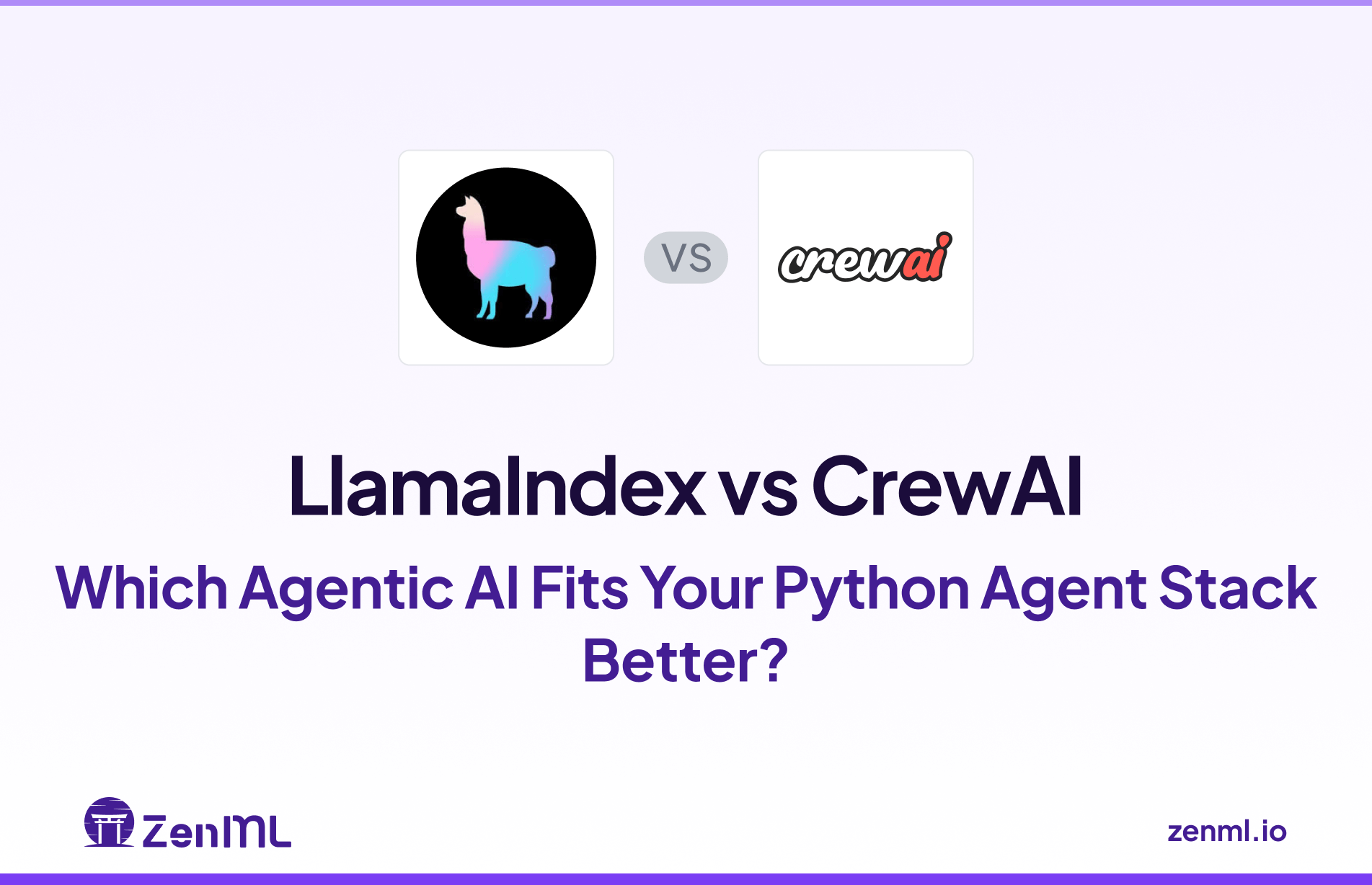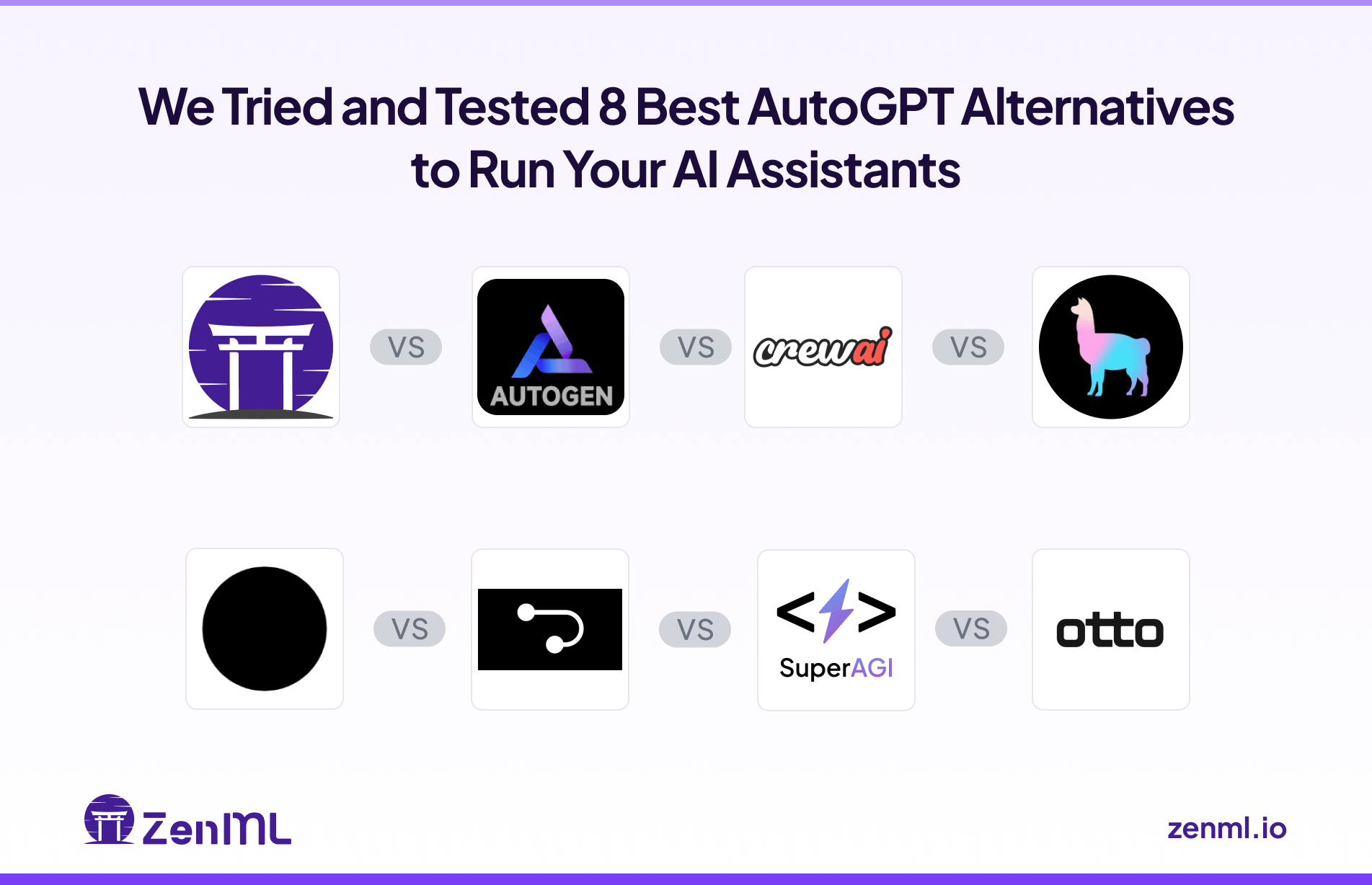
AutoGPT took the world by storm as an early autonomous agent experiment. Its ability to take a high-level goal, break it down into steps, and execute them recursively was a significant leap forward.
But it’s far from perfect. Teams moving to production often feel a lack of control, which leads to unreliable autonomy, high costs, and hallucinated outputs.
For engineers building production-grade AI assistants, these issues are non-negotiable. So in this article, you will learn about the top eight AutoGPT alternatives we tested for building and deploying reliable AI agents.
TL;DR
- Why Look for Alternatives: AutoGPT's open-ended autonomy often results in unreliable execution, runaway loops, and high token costs. Production applications require frameworks that offer more control, better planning, and robust observability.
- Who Should Care: ML engineers, Python developers, and teams building production AI agents who need more reliable autonomy. If you are building production-grade AI assistants that need to perform complex tasks reliably and efficiently, you will find a suitable alternative here.
- What to Expect: AutoGPT alternatives ranging from code-first frameworks to no-code platforms. All are open-source or have free tiers (with some offering paid plans). We compare how each handles agent task success, loop control, and monitoring, so you can choose the right one for your needs.
The Need for an AutoGPT Alternative?
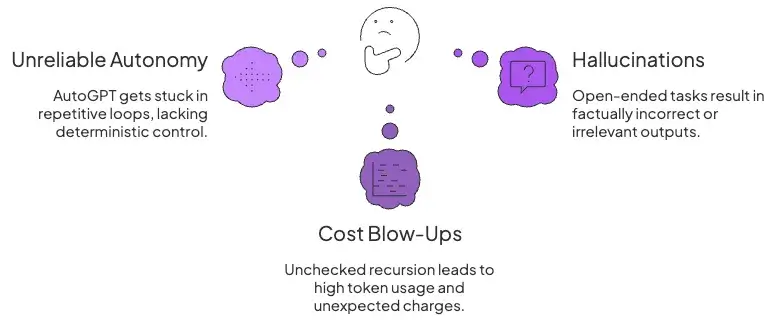
While AutoGPT is an excellent tool for demonstrating agent capabilities, its architecture presents several challenges in real-world applications. Here are the most important ones:
Reason 1. Runaway Loops and Unreliable Autonomy
AutoGPT gets stuck in repetitive loops instead of converging to a solution. Without tight human gating, the success rate for complex tasks drops. This lack of deterministic control makes its behavior unpredictable.
The free-form autonomy feels futuristic, but the lack of deterministic control makes its behavior unpredictable. Many developers want a framework that provides more deterministic control over the agent’s next steps to avoid these infinite loops or off-track rambles.
Reason 2. Cost Blow-Ups Under Recursion
Since AutoGPT is criticized for runaway loops, it’s risky to let it run unchecked. A single unattended run can rack up charges.
Users have seen a simple goal lead to hundreds of dollars in token usage if the agent doesn’t stop itself. Especially, long-running tasks trigger many OpenAI API requests, and there’s no built-in cost awareness or limit.
Reason 3. Hallucinations on Open-Ended Tasks
AutoGPT tends to hallucinate facts or pursue irrelevant tangents when given broad objectives. Without guardrails or early correction mechanisms, these errors compound and lead to irrelevant outcomes.
For example, an AutoGPT agent tasked with ‘researching a company’ might generate incorrect details and then build on those falsehoods.
That happens once or twice, and developers sprint towards AutoGPT alternatives that have integrated retrieval (to ground answers in real data) or frameworks that allow for validation and error correction on the spot.
Evaluation Criteria
Not all agent frameworks are built the same. We evaluated each AutoGPT alternative on three key questions:
- How accurate or useful are the outputs?
- What mechanisms exist to prevent endless loops or irrelevant actions?
- Can you monitor and debug what the agent is doing?
1. Task Success and Quality
We assessed how reliably each framework could complete complex, multi-step tasks. This includes the quality of the final output and the framework's ability to handle errors or unexpected obstacles without getting stuck.
2. Planning and Loop Control
Good alternatives provide more control over the agent’s planning and execution. It’s possible if the frameworks let you define structured workflows through graphs or role-based steps.
We examined whether the framework supports limiting iterations, using sub-agents for specific roles, or otherwise keeping the agent’s autonomy in check to prevent the chaos AutoGPT sometimes exhibits.
3. Observability
In production scenarios, you need insight into the agent’s decisions and resource use. As opposed to AutoGPT’s 'black box' runs, where you only see a console log after the fact. We evaluated each tool's built-in capabilities for logging, tracing, and debugging, which are essential for monitoring performance and diagnosing failures.
What are the Best Alternatives to AutoGPT
Here is a quick summary of the 8 best AutoGPT alternatives we tested:
1. ZenML
Best for: Teams that want a production-grade orchestration backbone for multi-agent and LLM workflows, with deterministic control, full lineage, and repeatability.
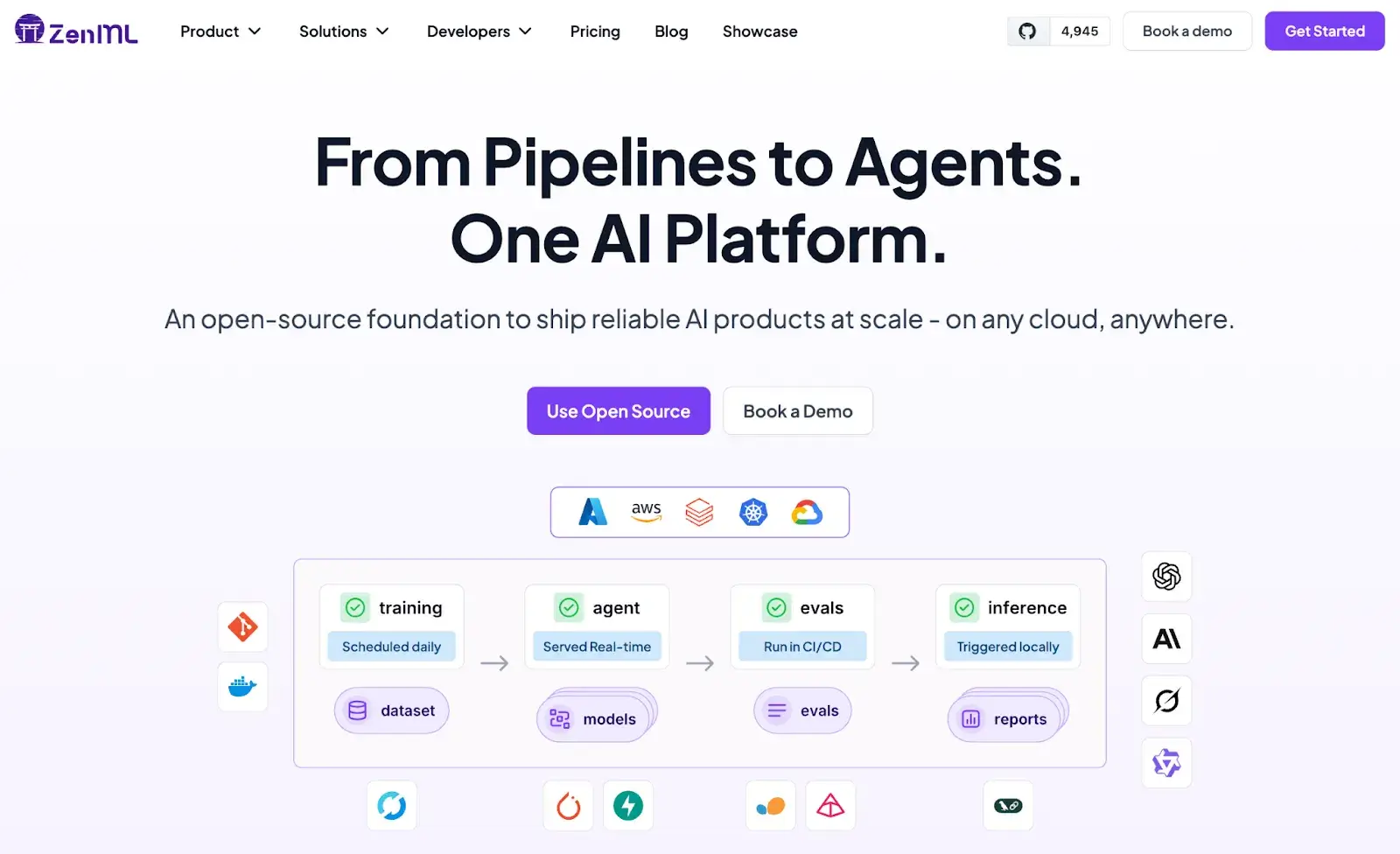
ZenML treats every agent/tool/LLM call as a pipeline step. That shift gives you hard guarantees on traceability, reproducibility, and loop control across runs, while plugging into familiar observability and experiment-tracking stacks. It unifies LLMOps + MLOps under one architecture, so you can move from notebook experiments to governed, auditable production workflows without rewrites.
Key Feature 1. Pipeline-Based Orchestration

ZenML’s pipeline API makes agent workflows deterministic: define steps (ingest → retrieve → reason → act → evaluate), version the artifacts, and run the same graph locally or on cloud/Kubernetes with zero code change.
This directly addresses AutoGPT-style runaway loops by enforcing explicit iteration caps, failure handling, and step boundaries. The quickstart shows how to stand up a reproducible pipeline in minutes, and the templates system lets you standardize these graphs org-wide.
Key Feature 2. Built-In Secrets Management
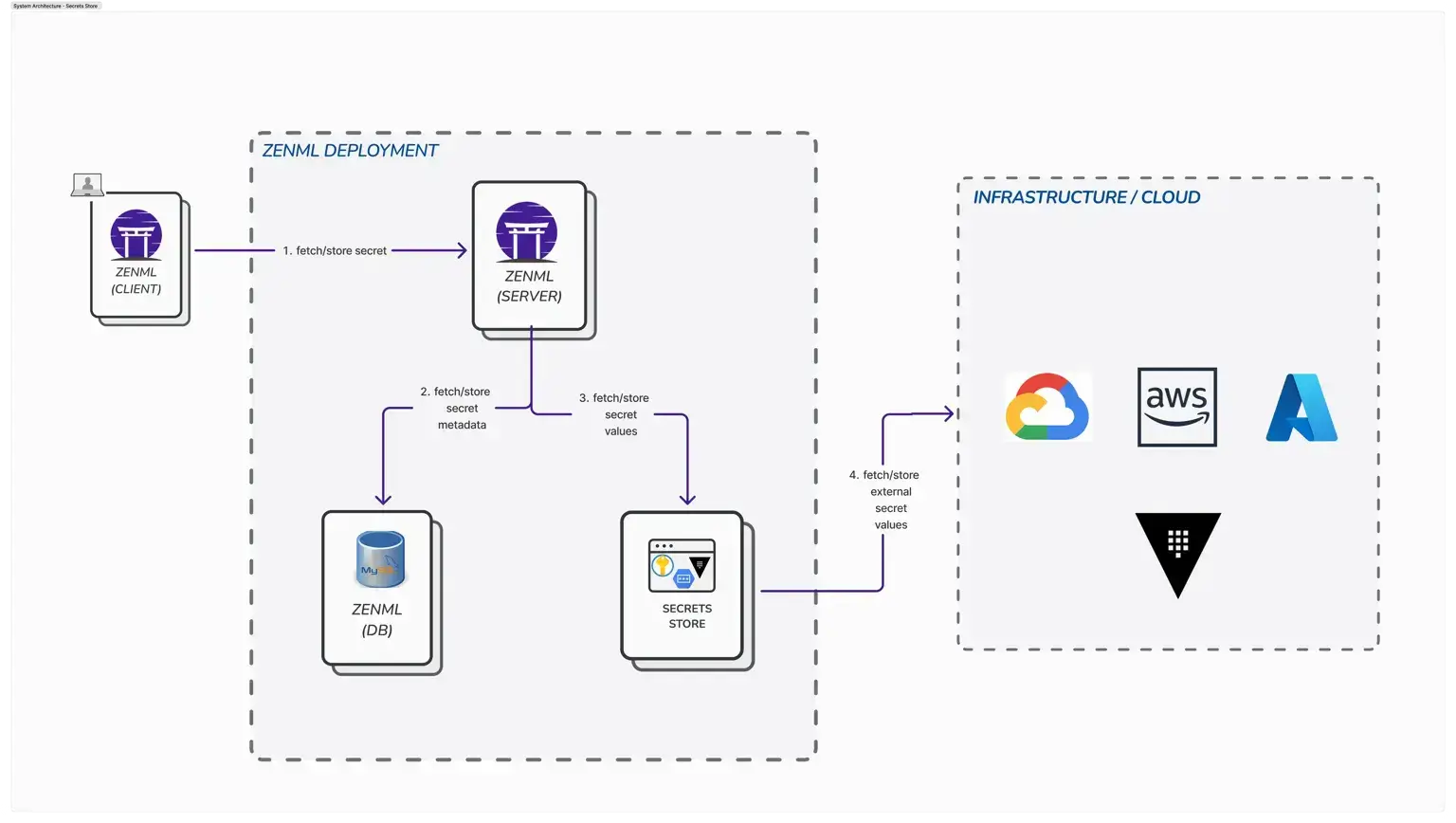
Agent stacks need API keys (OpenAI, search, vector DBs), database creds, and webhook tokens. ZenML ships a centralized secrets store with backends such as AWS/GCP/Vault, so pipelines pull secrets securely at runtime, never from code or logs.
This standardizes key handling across dev/stage/prod and supports DevSecOps controls (scopes, metadata, rotation via the backing manager).
Key Feature 3. RAG with ZenML
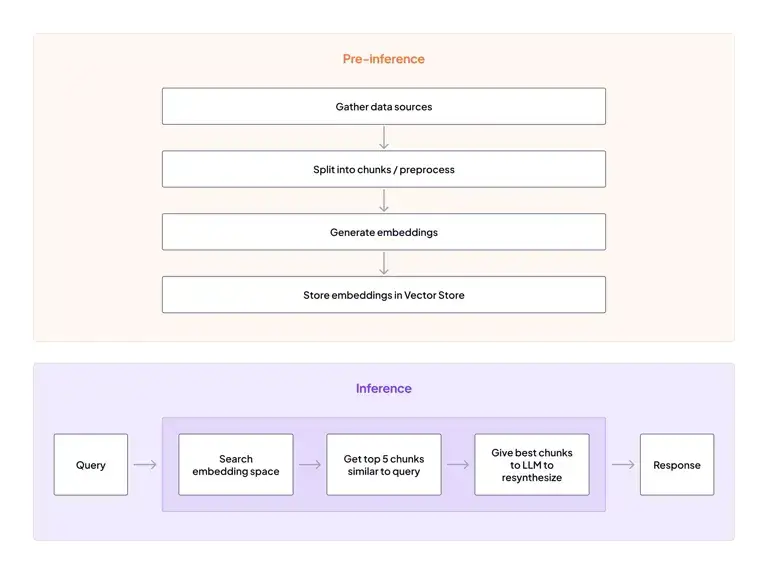
ZenML provides a production-ready RAG template that wires loaders, embedding jobs, vector stores (FAISS/Pinecone/Weaviate), generators, and evaluation into one tracked pipeline.
You get lineage for docs, chunks, and embeddings, plus retrieval and generation metrics in one place, so you can debug context drift, compare prompts/models, and improve recall/precision over time.
Pricing
We are upgrading our platform to bring every ML and LLM workflow into one place for you to run, track, and improve. Think of processes like data preparation, training, RAG indexing, agent orchestration, and more, all in one place.

Pros and Cons
The main advantage of ZenML is its end-to-end orchestration and reproducibility. It lets teams manage the entire lifecycle of LLM and MLOps workflows with integrated artifact tracking, secrets management, and infrastructure flexibility. With strong integrations (LangChain, MLflow, Hugging Face) and cross-environment portability, ZenML is ideal for enterprise-grade reliability and scalability.
But remember, ZenML isn’t a one-click QA or a specialized LLM observability SaaS; it’s a framework you compose with your preferred trackers and dashboards.
2. Autogen
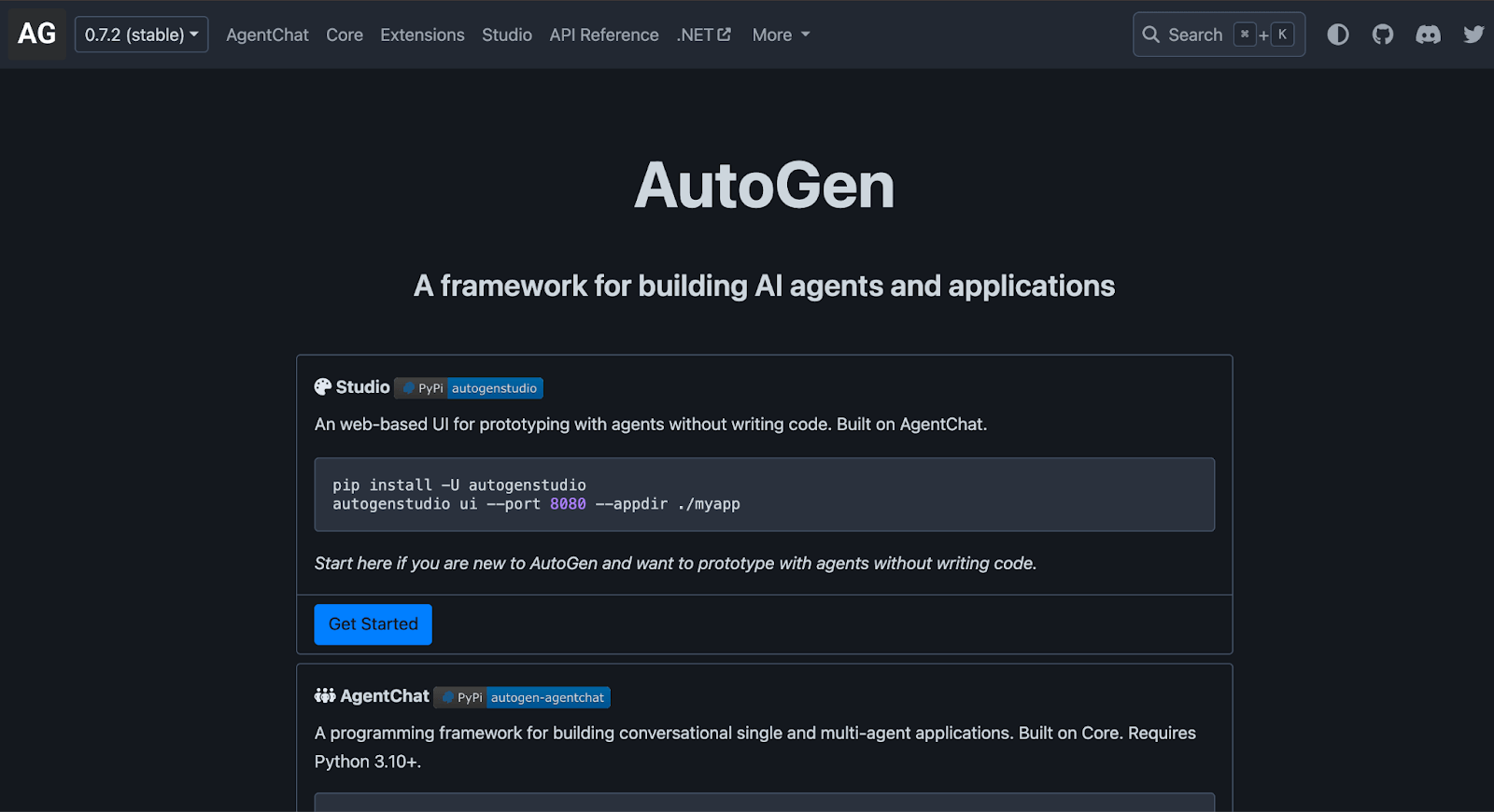
Autogen is an open-source framework from Microsoft for building agentic AI applications. It uses an asynchronous, event-driven architecture, which brings several benefits: agents can operate concurrently, you can mix and match different kinds of agents, and everything is logged.
Features
- Create customizable agents that can be specialized for different roles, such as writing code, executing it, and providing human-like feedback.
- Build conversational systems using high-level abstractions like
AssistantAgentandUserProxyAgent, which communicate via messages. This allows multiple agents to chat with each other to divide tasks and verify results. - Built-in tracing of agent messages and actions with support for OpenTelemetry, meaning you can hook it into dashboards to see each step an agent took.
- Incorporate humans into the workflow seamlessly, allowing for oversight and intervention at any step of the process.
Pricing
AutoGen is free to use. It’s an open-source project with Microsoft backing. You install the Python packages or build from source.
Pros and Cons
AutoGen's main strength is its flexibility in creating complex, multi-agent collaborations. Its conversational model is ideal for open-ended problems with unclear solution paths. Crucially, AutoGen’s observability and logging give you transparency that AutoGPT lacks.
On the flip side, AutoGen presents a steep learning curve. The jump from v0.2 to v0.4 was a complete redesign, which caused fragmentation in the user base. While better structured than AutoGPT, its core agent-to-agent chat model requires carefully designed conversation logic. Without this, agents can still behave unpredictably.
📚 Also read: AutoGen alternatives
3. CrewAI

CrewAI is a framework designed for orchestrating role-playing autonomous AI agents. It’s an excellent AutoGPT alternative when you need a team of specialized agents to collaborate on a task in a structured and deterministic manner.
Features
- Define agents with specific roles, goals, and tools, such as a 'Researcher' agent that gathers information and a 'Writer' agent that drafts content.
- Orchestrate multi-agent collaboration using sequential or hierarchical processes, ensuring agents perform actions one at a time in a loop or sequence you define, unlike AutoGPT’s uncontrolled looping.
- Equip agents with pre-built tools like web search, code execution, web scraping, or add custom tools with Python functions.
- Enable agents to share information through a built-in memory system, allowing for context to be maintained across tasks.
- Integrate with third-party observability services like Langfuse and Arize for logging, as well as MLflow and ZenML for experiment tracking.
Pricing
CrewAI’s core framework is licensed under the MIT license and is open-source. Other than that, it offers cloud-hosted plans to choose from:
- Basic: Free
- Professional: $25 per month
- Enterprise: Custom pricing
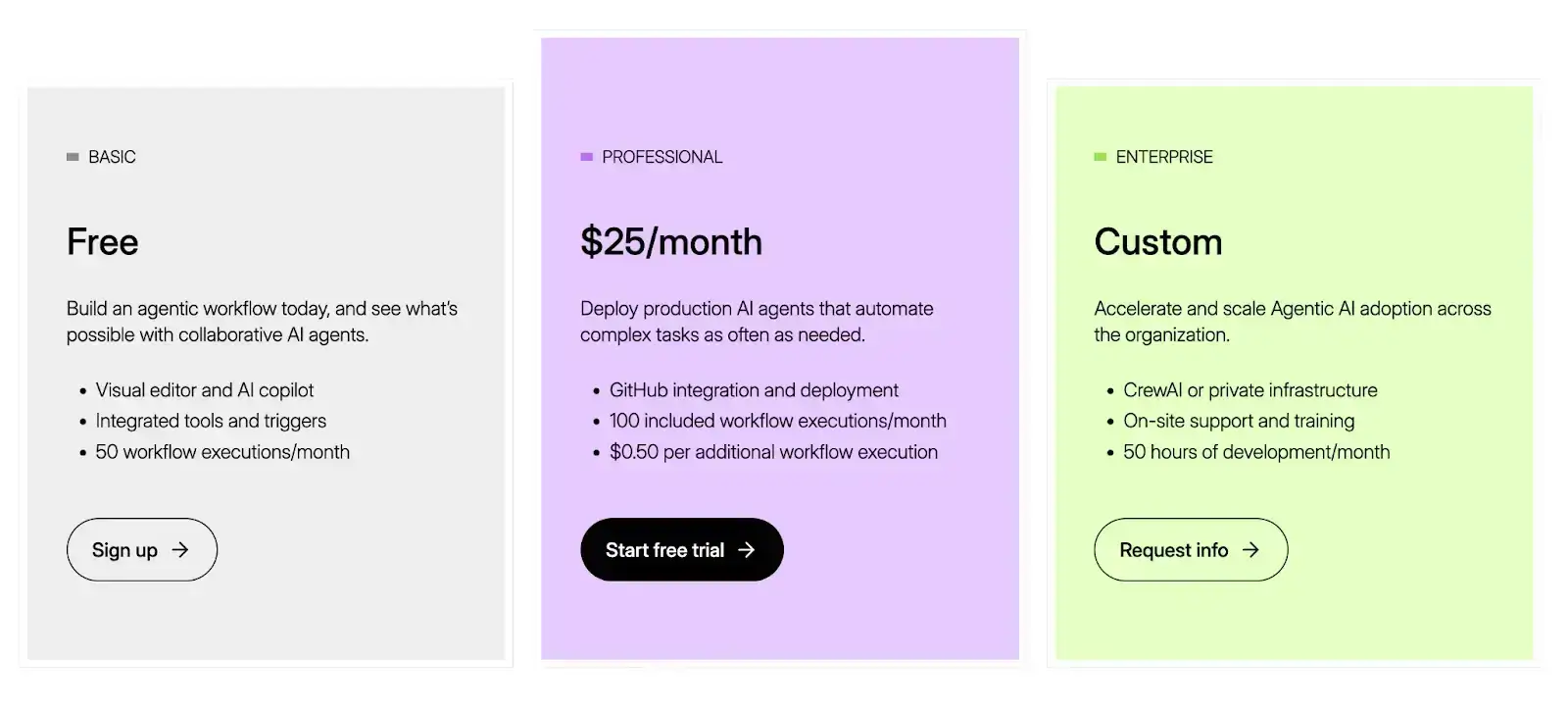
Pros and Cons
CrewAI's role-based approach makes multi-agent workflows more manageable and predictable than AutoGPT's chaotic model. You get predictable behavior patterns and accountability for each step. Non-developers on your team can even read or edit the YAML definitions for a CrewAI workflow.
The downside of a deterministic approach is less flexibility for open-ended exploration. All agents take turns, which is great for determinism but not as dynamic as AutoGPT’s freeform strategy. It also doesn’t support concurrent agent execution in the same run.
📚 Also read: Crewai alternatives
4. LlamaIndex
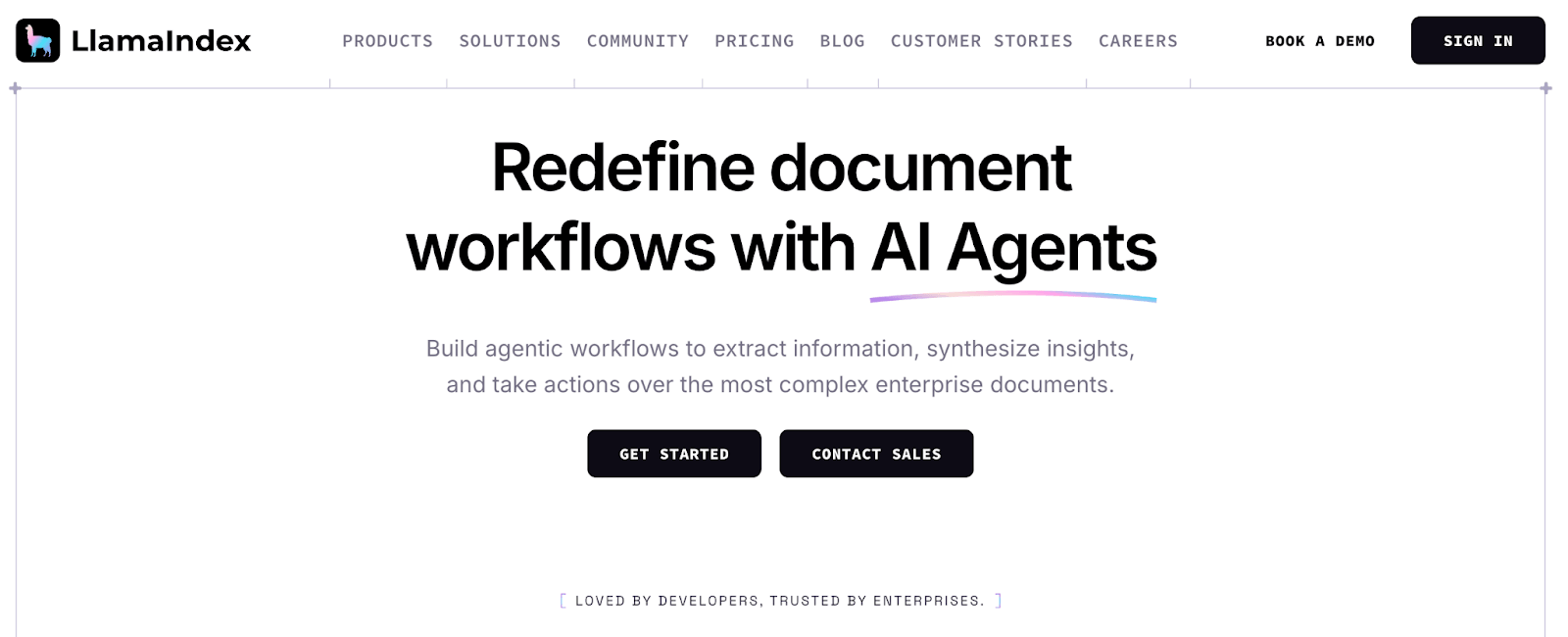
LlamaIndex (formerly GPT Index) is a powerful framework for augmenting LLMs with custom data. It excels at connecting your private or domain-specific data to LLMs, making it a superior AutoGPT alternative for tasks requiring deep reasoning over custom knowledge bases.
Features
- Ingest and index data from a wide variety of sources, including documents, PDFs, and databases, to create a knowledge base.
- Create various types of indices like vector store, keyword table, knowledge graph, etc., to provide agents with accurate, context-rich information instead of hallucinating.
- Orchestrate multi-step tasks with an
AgentFlowabstraction where you can define a Directed Acyclic Graph (DAG) of steps that query data or invoke tools in a structured and predictable manner. - Has a
FunctionAgentand tool execution capability, similar to AutoGPT plugins, but focused on data operations.
Pricing
LlamaIndex is free to use (open-source) for its core Python library. LlamaCloud, its managed service, offers a free tier and three premium tiers:
- LlamaIndex Starter: $50 per month - 50K API credits, 5 seats
- LlamaIndex Pro: $500 per month - 500K credits, 10 seats
- LlamaIndex Enterprise: Custom pricing
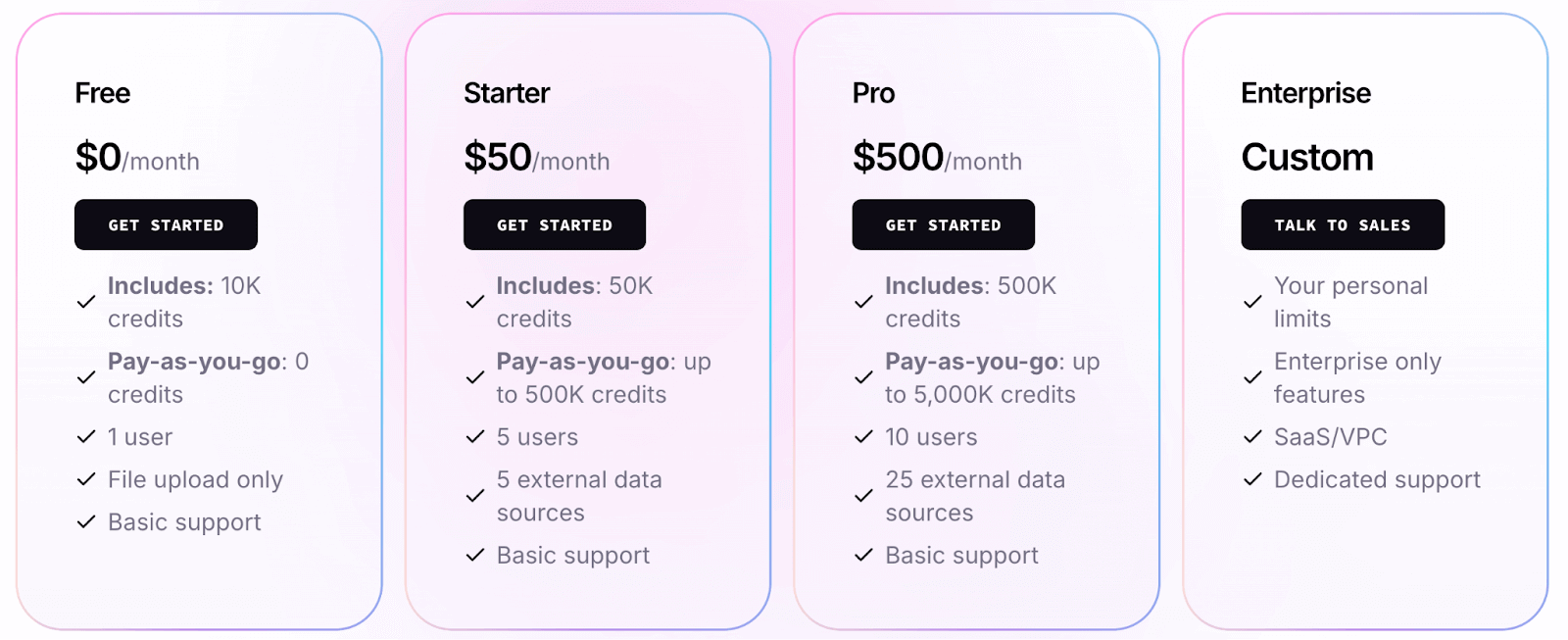
📚 Read more about LlamaIndex pricing.
Pros and Cons
LlamaIndex's major pro is its state-of-the-art RAG capabilities, which produce more accurate and well-grounded responses. It also includes evaluators to measure how well retrieval and answers are working, so you can systematically improve performance.
The major con is that LlamaIndex’s multi-agent orchestration is less developed than those in frameworks like AutoGen or CrewAI. It focuses on data augmentation and has basic tools for multi-step reasoning, but it doesn’t inherently handle multi-agent collaboration or complex planning logic.
📚 Also read: LlamaIndex alternatives
5. Open Interpreter

Open Interpreter is an open-source tool that allows language models to run code on your local machine. Think of it as your own ChatGPT Code Interpreter clone, but one you control.
As an alternative to AutoGPT, Open-Interpreter is great for tasks that involve code or automating things on your computer using natural language prompts.
Features
- Execute code in various languages, such as Python, R, and Bash, directly on your machine. You converse with Open-Interpreter in plain English, and it generates and executes code on your PC.
- Access your local file system to create, read, and modify files as needed to complete a task. It can browse the web using your browser, manipulate files, or use any software/library installed on your system.
- Enable the approval or permission step before running code so you can review exactly what command or script it wants to run, and you can approve or reject.
- Supports both interactive and programmatic modes; you can run it in a chat-like CLI where you type requests, or call it from custom Python code.
- Choose from community-driven plugins or profiles for specific use cases like an 'OS mode' to control your OS or integration with tools like E2B for sandboxed execution to tailor Open-Interpreter to particular domains.
Pricing
Open-Interpreter is completely free to use and is available as an open-source project on GitHub.
Pros and Cons
Open-Interpreter is extremely powerful for coding, data analysis, and automation tasks. There’s no ambiguous planning; it just writes and runs the needed code step by step with you in the loop. Besides, the safety net of user approvals addresses the scariest part of AutoGPT.
However, there’s some inflexibility. You need to have a suitable environment, like having Python installed, which you might find challenging. It lacks the advanced multi-agent orchestration features of cloud-based frameworks. Instead, it's more of an executioner that follows your instructions.
6. AgentGPT
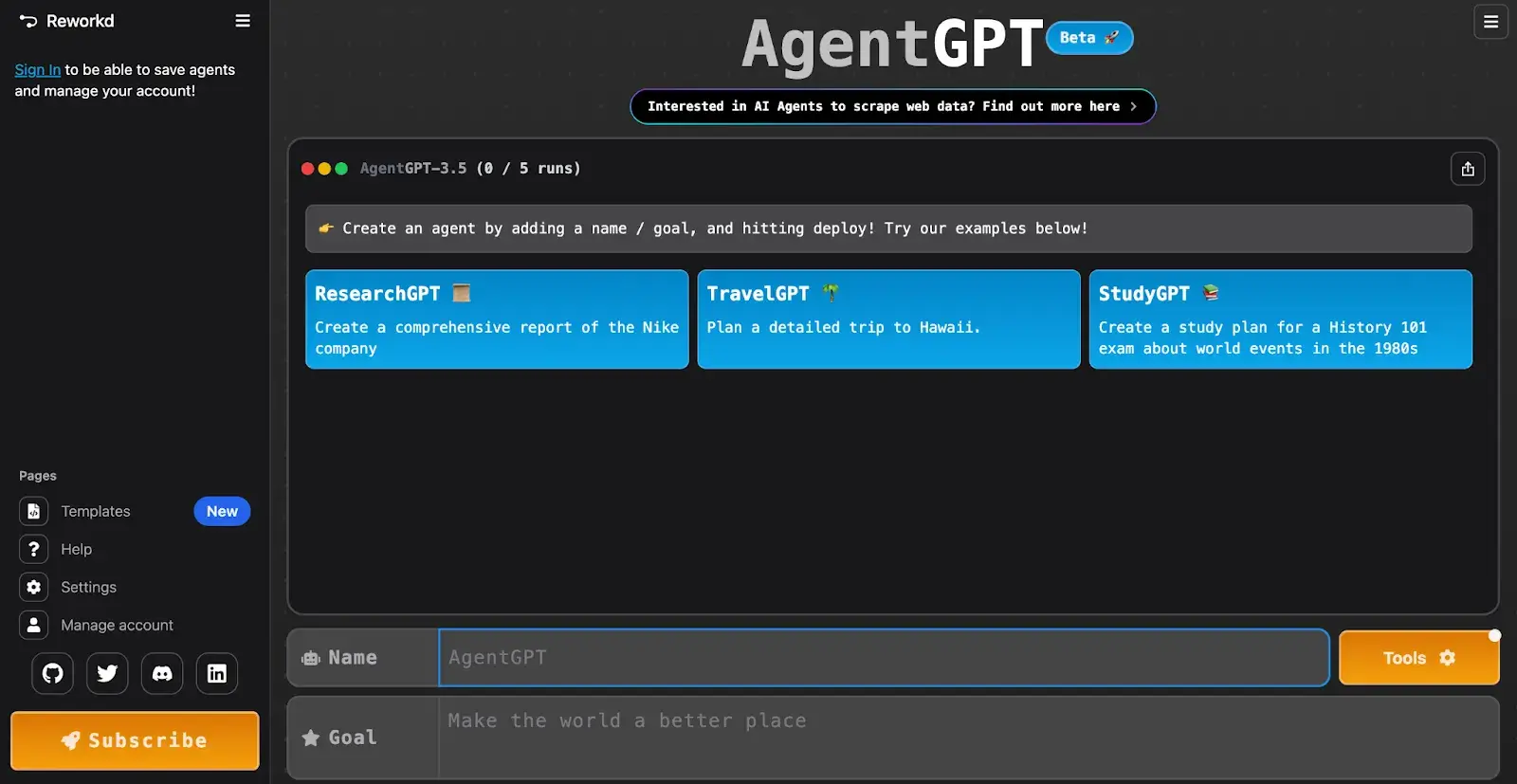
AgentGPT is essentially AutoGPT with a user-friendly face. It gained popularity as a web app that lets you configure and deploy an autonomous agent right in your browser, with no coding required.
Features
- Create and deploy autonomous agents through a user-friendly web interface by specifying a name and a goal.
- Like AutoGPT, it autonomously breaks the high-level goal into smaller tasks and executes them sequentially. You’ll see it generating its to-do list, executing each item, and updating the list.
- Plug-and-play tools that let agents browse the web, scrape content, use certain third-party APIs, and perform actions.
- Has a huge gallery of ready-to-deploy AI agent templates for different use cases, like an agent for research, event planning, email, fitness, and news.
Pricing
AgentGPT offers a free plan with limited features and two paid plans:
- AgentGPT Pro: $40 per month
- AgentGPT Enterprise: Custom pricing
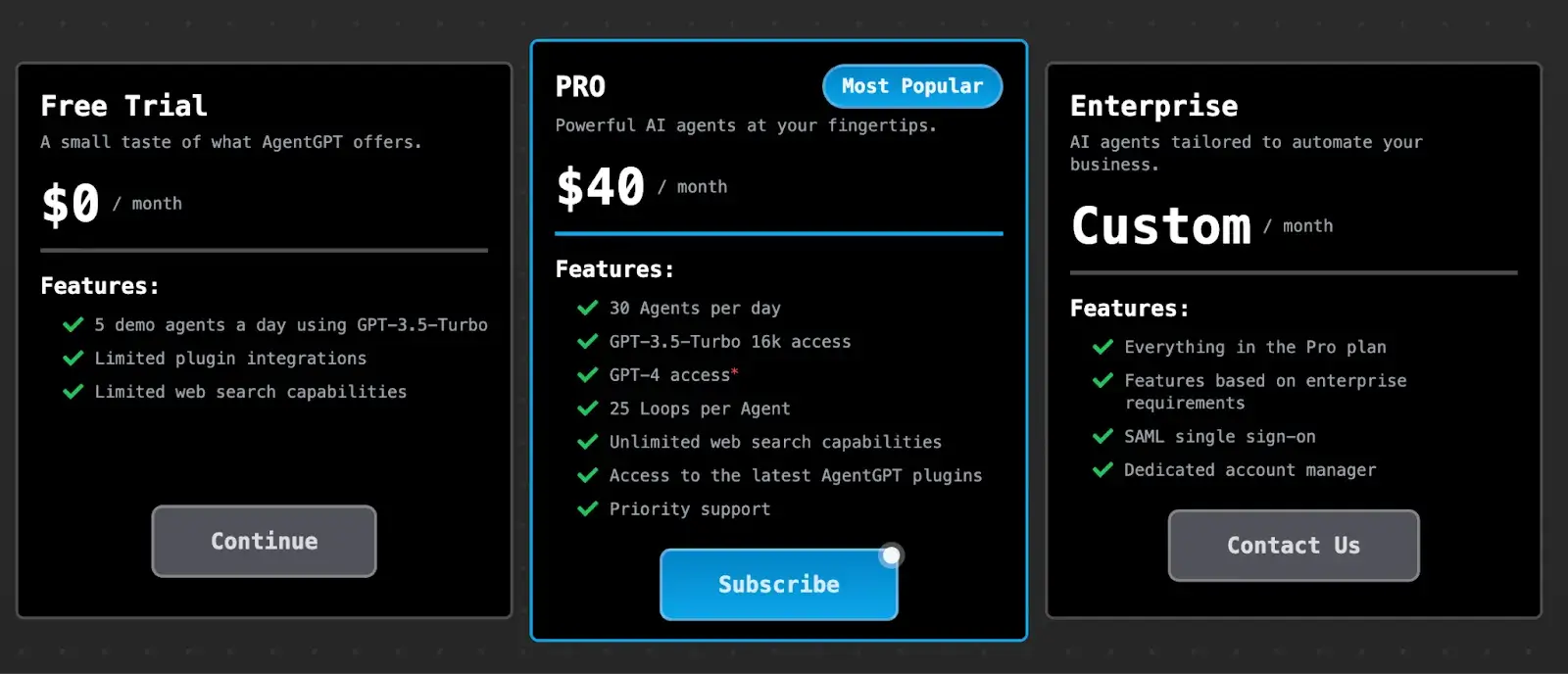
Pros and Cons
AgentGPT’s biggest flex is ease of use. In literally seconds, anyone can have an autonomous agent running. It’s great for demonstration purposes or quick one-off tasks. Also, because it’s cloud-based, it offloads the computation; you can run fairly heavy tasks from a mere web browser.
The platform's simplicity, however, means it lacks the deep customization and control offered by code-based frameworks. Many of the underlying issues of AutoGPT still apply. The agent can still go off track and get stuck in loops.
7. SuperAGI
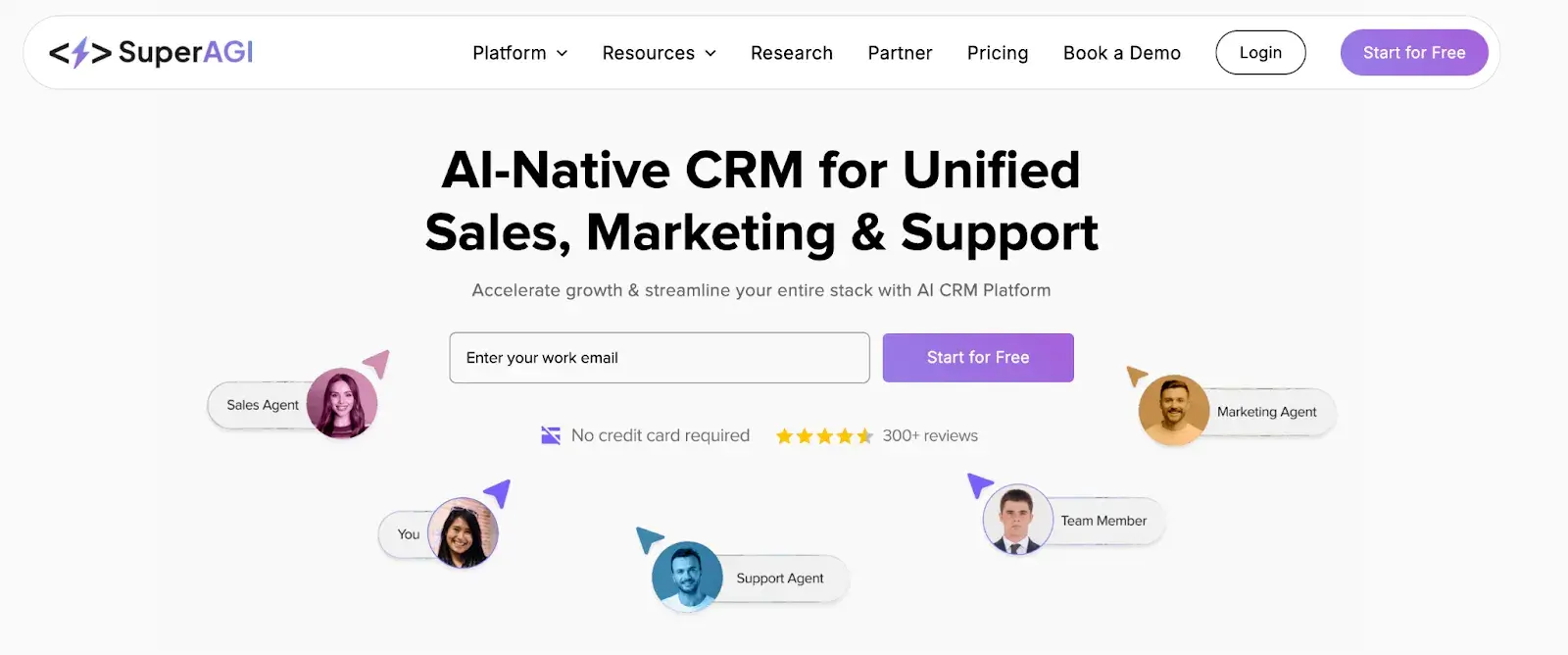
SuperAGI is a dev-first, open-source framework for building and managing useful autonomous agents. It’s an attractive alternative to AutoGPT for those who want an extensible system to build upon, and perhaps run it in a cloud environment with collaboration.
Features
- Build and test agents in a visual environment, which simplifies the development and debugging process.
- Supports running multiple agents and even multi-step workflows within an agent’s plan with features like retry mechanisms, timeouts, and resource management.
- Extend agent capabilities with a wide range of pre-built tools, extensions, and templates from its marketplace or create custom tools and memory backend using an SDK.
- Monitor and analyze agent performance, runs, and token usage in real-time through a dedicated dashboard.
- Built-in Docker compatibility lets you containerize and deploy projects efficiently.
Pricing
SuperAGI offers a managed cloud version with a free tier and two premium plans:
- Starter: $9 per user per month
- Growth: $49 per user per month
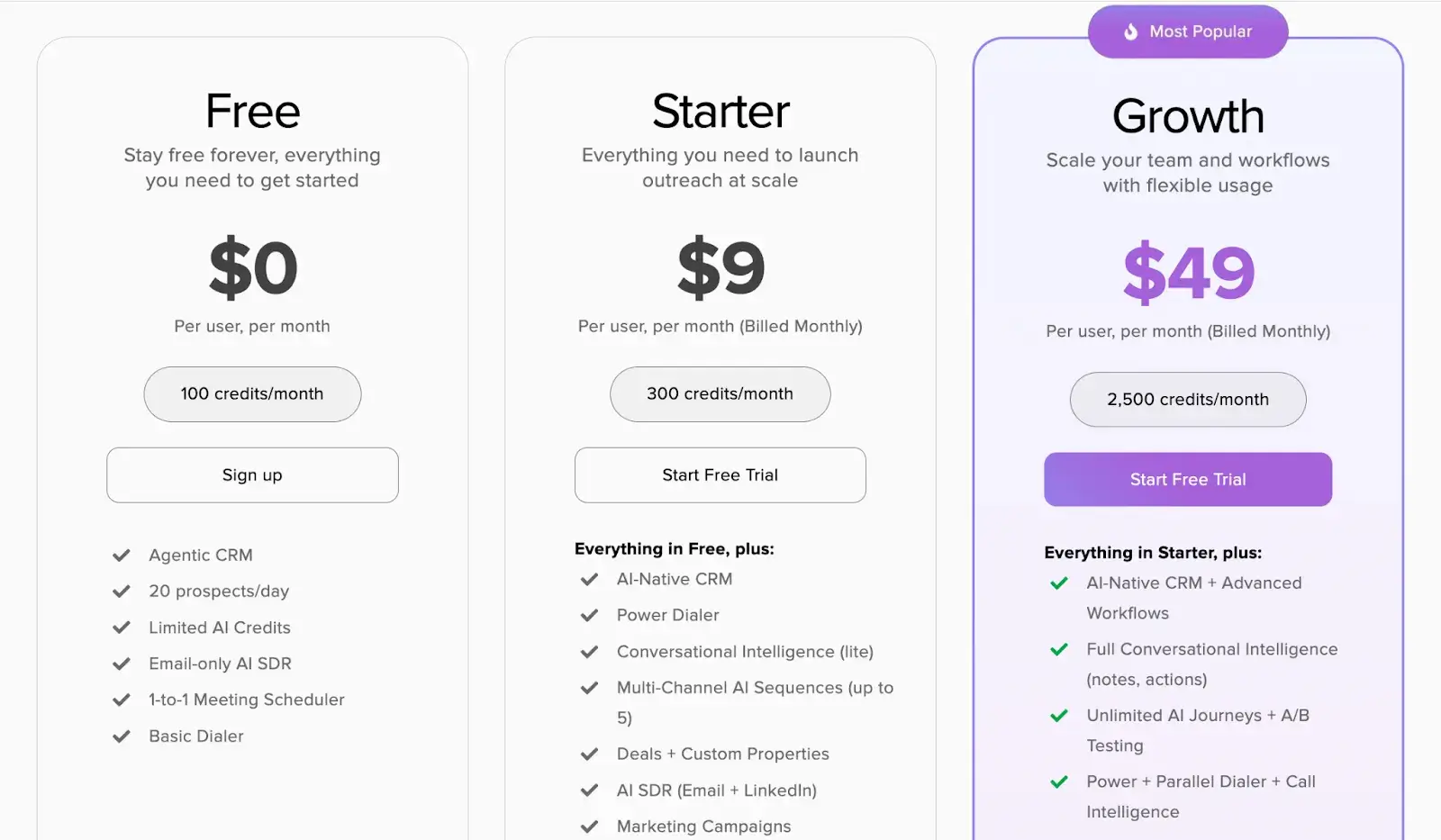
Pros and Cons
SuperAGI provides the building blocks to create and monitor agents. It supplies key observability and management features that similar platforms often lack. Its developer-focused design also ensures greater control and transparency compared to black-box cloud services.
On the other hand, SuperAGI is a newer platform with features still evolving, like its early-stage tracing and collaboration tools. You may encounter bugs and frequent updates as the platform evolves. Furthermore, its complexity means that self-hosting requires DevOps expertise to manage all of its components effectively.
8. Otto

Otto lets you create and deploy AI agents to automate business workflows. Imagine giving an AI a list of companies or URLs in a table and telling it to fill in the blanks with information; that’s Otto’s sweet spot. It’s tailored for data research and enrichment tasks, presented in a spreadsheet-like interface.
Features
- Has a familiar, spreadsheet-like UI where each row is an item and each column is an AI task configured via a natural language description or selecting from pre-built templates.
- Offers ready-to-use AI agent templates for use cases like Company Research, List Enrichment, Web Scraping, Document Q&A, etc.
- Connect agents to your existing business tools like CRMs, Slack, and email to integrate them into daily workflows.
- Execute multiple rows in parallel or chain multiple agents together to execute complex, multi-step processes from start to finish.
Pricing
Otto offers a generous free plan for individual use. Other than that, it has three paid plans:
- Starter: $99 per month
- Pro: $299 per month
- Enterprise: Custom pricing
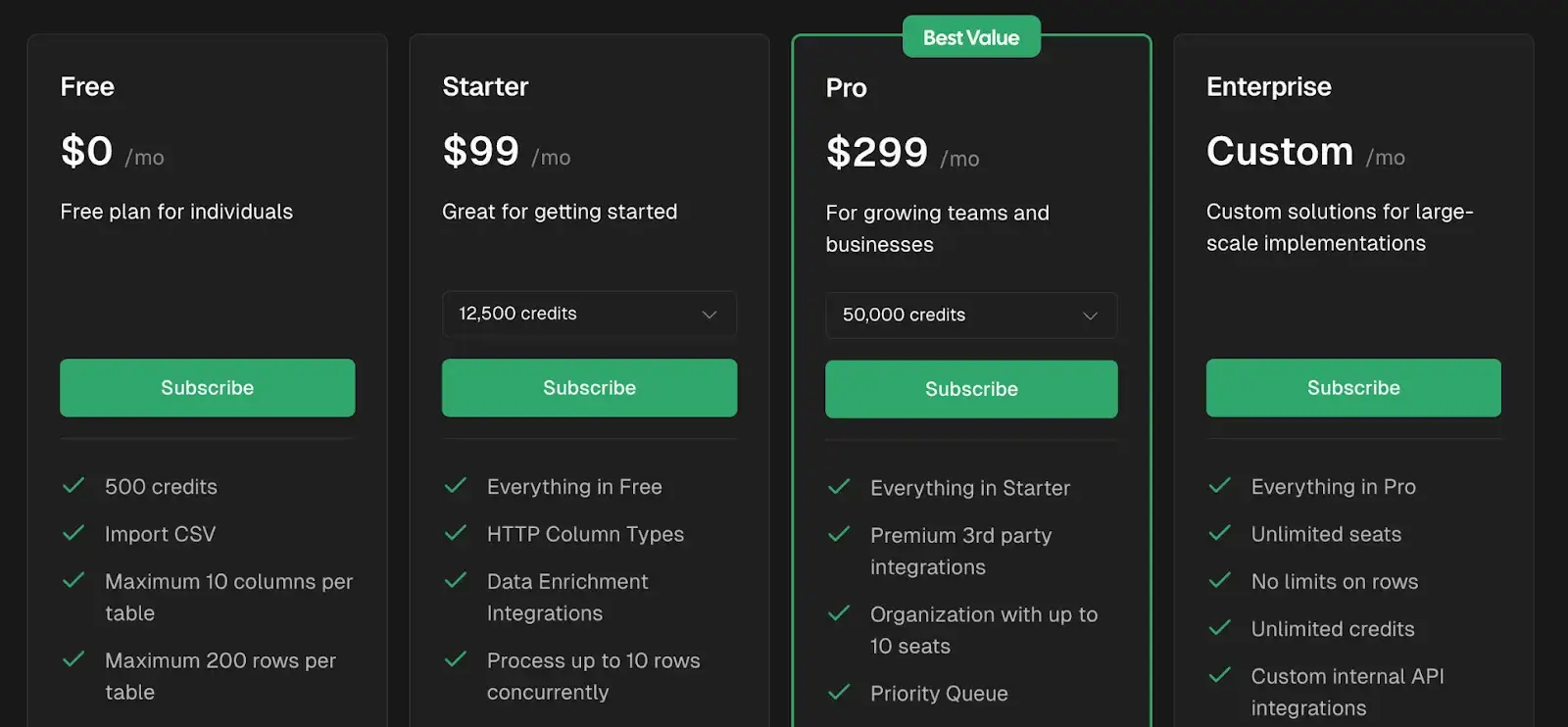
Pros and Cons
Otto is highly optimized for its niche. For tasks like enriching a list of leads with missing info, or extracting structured data from a bunch of documents, it provides a level of control and clarity that AutoGPT never could. The familiar spreadsheet-like interface speeds up development time.
The obvious con is limited scope. Outside of research/enrichment tasks, Otto isn’t general-purpose. If you asked it to, say, design a marketing strategy or solve a puzzle, that’s not what it’s for. While it does allow custom prompts for columns, you might hit its limits if your needs don’t fit the table paradigm.
The Best AutoGPT Alternatives to Build Automated AI Workflows
AutoGPT deserves credit for showing what autonomous agents could become, but production teams need what actually works. The next generation of agent frameworks is moving away from chaotic recursion toward structured, observable, and deterministic autonomy.
Tools like CrewAI and AutoGen show how multi-agent collaboration can stay grounded through defined roles and message passing. LlamaIndex brings retrieval into the loop, reducing hallucinations and grounding reasoning in real data. Frameworks like SuperAGI and Otto simplify orchestration, each addressing specific operational pain points.
But if you’re an engineer thinking beyond experimentation, toward reproducibility, lifecycle management, and governance, ZenML stands out. It’s not just another agent framework. It’s a complete MLOps + LLMOps platform that lets you move from notebooks to production pipelines without losing observability or control. You can version every artifact, integrate tracing, manage secrets, and plug in your RAG or agent workflows, all in one stack.
In short: AutoGPT sparked the movement; frameworks like ZenML are defining its future. If your goal is to build reliable, traceable, and production-grade AI assistants, you’re not just looking for an AutoGPT replacement. You’re looking for a foundation. And ZenML is that foundation.
If you’re interested in taking your AI agent projects to the next level, consider joining the ZenML waitlist. We’re building our first-class support for agentic frameworks (like LangGraph, CrewAI, and more) inside ZenML, and we’d love early feedback from users pushing the boundaries of what AI agents can do. With ZenML, you can seamlessly integrate whichever agent framework you choose into robust, production-grade workflows. Join our waitlist to get started.👇



